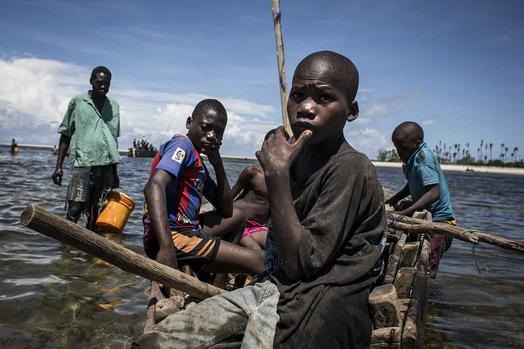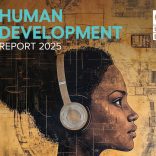Mozambique: Drivers of vehicles involved in the accidents that caused 35 deaths must be held ...
Maputo lures child workers

AFP (File photo) / No school: Young Mozambican fishermen return to the shore after several days of fishing in Palma.
Sunrise has barely set in at about 6am in Lichinga, the capital of Mozambique’s northern Niassa Province, and teenager Jossias is already in the market.
He is not on his way to school, as one would expect of someone his age. Oblivious of international laws dissuading child labour, he considers his “work” easy despite lifting loads of 25kg or more.
“I am 15 years old,” he discloses.
“It doesn’t seem fine to me to be asking my parents for money,” he says. “I help people carry loads, mostly rice. I also unload trucks. My friends also do that.”
The weight of the loads Jossias carries daily vary from 25kg to the most he is able to lift. He can carry 10 loads on a “good” day.
People who perform such tasks in the southern African country are called madjovidjos or gai-gais.
Those who hire Jossias see an advantage over his colleagues because he is young. Other gai-gais are usually old, weak and compromised by alcohol.
After his day’s work, Jossias receives some money and goes home to watch television. Since all the big Mozambican media houses are headquartered in the capital Maputo city, the image Jossias and most of his friends have of the city is of high-rise buildings, good cars, the best universities and luxurious shopping centres.
Whoever goes to Maputo is expected to return home rich or at least financially stable.
As statistics from the first National Survey on the Informal Sector carried out by the National Institute of Statistics show, if Jossias went to Maputo, his fate as an uneducated under-aged Mozambican would not change much.
With 1.3million people living in the city and with most of them having come from other provinces to seek better conditions, statistics indicate most of them end up as informal workers with dreams of wealth only being pipe dreams.
The numbers show that for people like Jossias, moving to Maputo means joining a crowd of street sellers or gai-gais in one of the capital’s big markets – Xipamanine, Junta, Malanga – or most probably downtown in Baixa, where Mozambicans throng to buy imported products.
The Chinese, Indians, Nigerians, South Africans and other nationalities have the biggest share of the informal market in the country. If Jossias decided to head to Maputo as anticipated, he would probably meet Carlos, also aged 15.
Carlos works for more than 10 hours a day to make ends meet.
He wakes up by 4am because Maputo downtown is a 10km walk from his home.
Carlos must reach his so-called workplace before the shops open and other colleagues arrive.
He sells cookies. He is just one of thousands of children who sell that kind of snack in the markets.
Carlos has to contend with older, stronger and mostly violent young men. Like Jossias, he dropped out of school in the seventh grade after the government stopped providing him with free education.
Orphaned and without money to afford secondary school, he opted to look for a job to feed himself and his grandparents.
His earnings range between $2 and $5. From those, he is authorised to use only 20 cents a day to feed himself. That is to make sure that some profit is left for his employer.
He stops work at about 9pm, and then walks back to the employer’s house, reaches the place an hour-and-a-half later, delivers the money and is released to go home. That routine takes place Monday to Saturday.
At the end of the month, he receives between $8 and $10, which is managed by his grandparents.
Negotiations by the grandparents for a salary increase for the teen have been unsuccessful.
According to the International Labour Organisation (ILO), about 4 million Mozambican children are labourers. This is out of the country’s total child population of 14 million, almost half of Mozambique’s total population.
In the rural areas, children work in farms and mines. Their salaries are even lower than those of the children working in the urban markets. The UN Children’s Fund, the ILO and the ministry for labour and social welfare are expected to release a more specific study pointing out the main forms of child labour in the country.
It is hoped that this will help to establish a means to prosecute employers of minors.
Preliminary data provided by the Universidade Eduardo Mondlane, the country’s major university, indicates prostitution and mining are the worst forms of child labour.
ILO country representative Igor Felice believes agriculture, informal trade and domestic work are the most worrying trades: “These are invisible sectors since children are usually inside residences.”
Nonetheless, he said the problem was not around legislation; it was around its implementation.
“Laws preclude child labour, but it is complicated,” he said.
“Sectors such as agriculture are difficult for labour inspectors to be able to detect working children and to implement measures to prevent child labour.”
Minister of Labour and Social Security Vitoria Diogo denounced child labour as deplorable. “This exploitation of minors in our country is not acceptable. We want to fight it,” he assured.
By Berta Madime













Leave a Reply
Be the First to Comment!
You must be logged in to post a comment.
You must be logged in to post a comment.